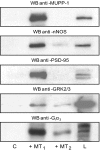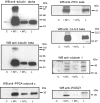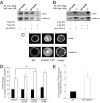A generic approach for the purification of signaling complexes that specifically interact with the carboxyl-terminal domain of G protein-coupled receptors
- PMID: 18448421
- PMCID: PMC2500234
- DOI: 10.1074/mcp.M700435-MCP200
A generic approach for the purification of signaling complexes that specifically interact with the carboxyl-terminal domain of G protein-coupled receptors
Abstract
G protein-coupled receptors (GPCRs) constitute the largest family of membrane receptors and are major drug targets. Recent progress has shown that GPCRs are part of large protein complexes that regulate their activity. We present here a generic approach for identification of these complexes that is based on the use of receptor subdomains and that overcomes the limitations of currently used genetics and proteomics approaches. Our approach consists of a carefully balanced combination of chemically synthesized His6-tagged baits, immobilized metal affinity chromatography, one- and two-dimensional gel electrophoresis separation and mass spectrometric identification. The carboxyl-terminal tails (C-tails) of the human MT1 and MT2 melatonin receptors, two class A GPCRs, were used as models to purify protein complexes from mouse brain lysates. We identified 32 proteins that interacted with the C-tail of MT1, 14 proteins that interacted with the C-tail of MT2, and eight proteins that interacted with both C-tails. Several randomly selected proteins were validated by Western blotting, and the functional relevance of our data was further confirmed by showing the interaction between the full-length MT1 and the regulator of G protein signaling Z1 in transfected HEK 293 cells and native tissue. Taken together, we have established an integrated and generic purification strategy for the identification of high quality and functionally relevant GPCR-associated protein complexes that significantly widens the repertoire of available techniques.
Figures





References
-
- Fredriksson, R., Lagerstrom, M. C., Lundin, L. G., and Schioth, H. B. ( 2003) The G-protein-coupled receptors in the human genome form five main families. Phylogenetic analysis, paralogon groups, and fingerprints. Mol. Pharmacol. 63, 1256–1272 - PubMed
-
- Vassilatis, D. K., Hohmann, J. G., Zeng, H., Li, F., Ranchalis, J. E., Mortrud, M. T., Brown, A., Rodriguez, S. S., Weller, J. R., Wright, A. C., Bergmann, J. E., and Gaitanaris, G. A. ( 2003) The G protein-coupled receptor repertoires of human and mouse. Proc. Natl. Acad. Sci. U. S. A. 100, 4903–4908 - PMC - PubMed
-
- Ellis, C., and The Nature Reviews Drug Discovery GPCR Questionnaire Participants ( 2004) The state of GPCR research in 2004. Nat. Rev. Drug Discov. 3, 575, 577–626 - PubMed
-
- Milligan, G., and White, J. H. ( 2001) Protein-protein interactions at G-protein-coupled receptors. Trends Pharmacol. Sci. 22, 513–518 - PubMed
-
- Dev, K. K., Nakanishi, S., and Henley, J. M. ( 2001) Regulation of mglu7 receptors by proteins that interact with the intracellular C-terminus. Trends Pharmacol. Sci. 22, 355–361 - PubMed
Publication types
MeSH terms
Substances
LinkOut - more resources
Full Text Sources
Molecular Biology Databases
Miscellaneous

